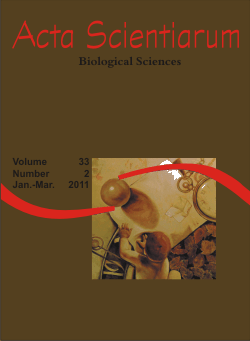<b>Thermal structure of the Poraquê lake, Central Amazonian, Brazil</b> - doi: 10.4025/actascibiolsci.v33i2.5150
Resumo
Thermal gradient of a Central Amazonian lake was studied to establish a link between seasonal variations in the water level, temperature, suspended particulate matter (SPM) and thermal stratification. Bimonthly measurements of temperature and PAR radiation were made at 0.25 m intervals from the surface to bottom from February 2004 to July 2006. Daily occurs full vertical mixing of the water column, and classic thermal stratification was not observed in the period. The effect of the winds associated to flood-pulse and the penetrative convection, transported the turbulent kinetic energy (TKE) into the lake mixing the column of water. This phenomenon was more expressive in the rainfall seasons when is generally higher contributing to the circulation of the water. The limit of the euphotic zone ranged from 1.36 to 1.77 m in the period studied. The results of the transmission curves for the sampling sites showed that, in general, less than 0.01% of the surface light reached the bottom. The trend curve developed can facilitate the understanding of the limnological and ecological processes in lentic systems of whitewaters of the Central Amazonian.Downloads
DECLARAÇÃO DE ORIGINALIDADE E DIREITOS AUTORAIS
Declaro que o presente artigo é original, não tendo sido submetido à publicação em qualquer outro periódico nacional ou internacional, quer seja em parte ou em sua totalidade.
Os direitos autorais pertencem exclusivamente aos autores. Os direitos de licenciamento utilizados pelo periódico é a licença Creative Commons Attribution 4.0 (CC BY 4.0): são permitidos o compartilhamento (cópia e distribuição do material em qualqer meio ou formato) e adaptação (remix, transformação e criação de material a partir do conteúdo assim licenciado para quaisquer fins, inclusive comerciais.
Recomenda-se a leitura desse link para maiores informações sobre o tema: fornecimento de créditos e referências de forma correta, entre outros detalhes cruciais para uso adequado do material licenciado.












1.png)




3.png)













